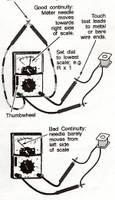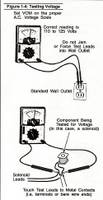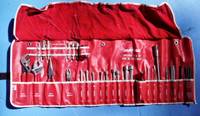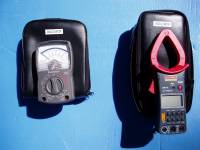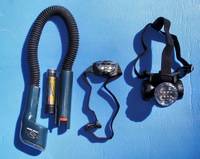As many of you know, the Samurai had back surgery last week for a ruptured disk at L4-L5. The surgery went well but I’m out of action for the next three months while my back heals up. Last week, just four days after my surgery, our neighbor’s refrigerator crapped out on them… again. The refrigerator is a Maytag top and bottom with one of those wimpy Panasonic evaporator fan motors. I had previously replaced the motor because it had burned out and, from what they described (fan in the freezer not running), it sounded like the motor might have burned out again. Dayyam! Well, the Samurai is dedicated to his craft and, fresh back surgery not withstanding, I was duty-bound to fix that refrigerator. So, I did what any Samurai Appliance Repair Man would do in my situation: I drafted two of my Samurai reproductive units into service to help me fix our neighbor’s refrigerator.
So I grabbed a fresh brewski (Sam Adams Winter Lager) and summoned two of my reproductive units to begin their apprenticeship training. Ollie grabbed my tool bag from my workshop, Samenilla tucked my clipboard under his arm, and together we trudged outside into the frigid New Hampshire day. I fished a new evaporator fan motor out of my service van and hobbled off through the snow and ice with my two apprentices to our neighbor’s house.
Our neighbors weren’t home so we went on inside and were greeted by their two elderly and rotund rottweilers. I opened the freezer door and, sho ’nuff, the fan motor was dead. I instructed my two apprentices to remove everything from the freezer. Once emptied, I guided Samurai Apprentice Ollie on removing the freezer back wall retaining screws so we could access the fan motor. Here she is in action:

Samurai Apprentice, Ollie, Dismantles the Freezer Compartment
As soon as the back wall tilted forward, the fan motor started running! My slightly fermented brain told me that we had a bad connection somewhere. My keen, Vulcan squinties located the problem right away as soon as I removed the power plug to the fan motor. One of the wire pins in the connector was fuzzed out with blue mold, as you can sort of see below:
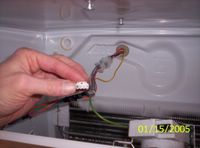
Moldy Evaporator Fan Motor Connector Plug
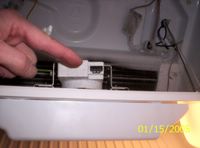
Connector Socket on the Evaporator Fan
The preferred fix in this situation would be to replace the connector plug. But I didn’t have one. Now, here’s where my years of being a certifiable appliance parts changer paid off in spades. I picked out as much mold as I could with a piece of wire, reconnected the harness and the motor ran fine. Then I gave it the tug test: good to go.
Everything was proceeding nicely except a new problem suddenly emerged: I had finished my beer and was now working sudsless! This was a crisis of the highest order so I made an emergency phone call to Mrs. Samurai. She sprang into action and sprinted down to the neighbor’s house with a fresh brewski. Now that’s what I call the perfect woman!
Samurai Apprentice Samenilla re-assembled the freezer back wall. Here he is in action:

Samurai Apprentice, Samenilla, Demonstrates His Nutdriver Technique
So, with the help of two apprentices, the Samurai fixed a refrigerator just four days after having back surgery. If I were doing all the work myself (before back surgery), I could have torn the freezer apart, made the repair, and reassembled it all on a single bottle of beer. And rightly so, since this repair only rates a single mug on the SUDS-o-meter. But here’s the moral of the story: you have to invest time in your apprentices if you’re going to pass on the craft to the next generation of appliance parts changers thus preserving and defending truth, justice, and the Ameedican Way.





